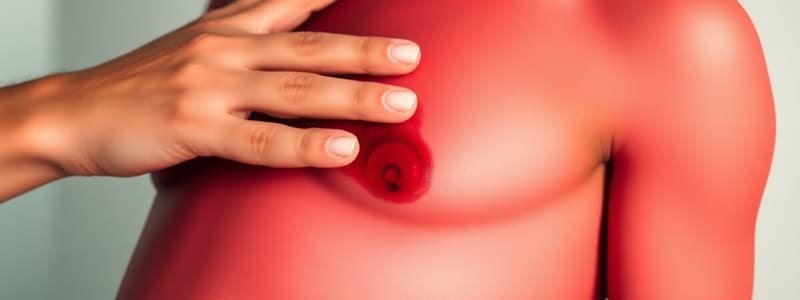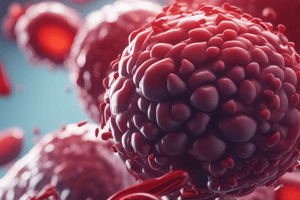Podcast
Questions and Answers
What is the primary physiological response of the body to vessel injury?
What is the primary physiological response of the body to vessel injury?
- Inflammation
- Nerve regeneration
- Haemostasis (correct)
- Hemoglobin synthesis
Which step involves the temporary blocking of the injury site in haemostasis?
Which step involves the temporary blocking of the injury site in haemostasis?
- Vasoconstriction
- Activation of platelets (correct)
- Skin regeneration
- Activation of the immune response
What occurs as a result of the activation of the coagulation cascade in the haemostasis process?
What occurs as a result of the activation of the coagulation cascade in the haemostasis process?
- Production of red blood cells
- Vasodilation of blood vessels
- Reduction of blood pressure
- Thrombus formation (correct)
Which of the following best describes the role of fibrin in haemostasis?
Which of the following best describes the role of fibrin in haemostasis?
What is the impact of ischaemia in the context of clot formation?
What is the impact of ischaemia in the context of clot formation?
What describes the composition of a thrombus?
What describes the composition of a thrombus?
Which of the following correctly represents the relationship between ischaemia and infarction?
Which of the following correctly represents the relationship between ischaemia and infarction?
What role does plasminogen play in the fibrinolytic system?
What role does plasminogen play in the fibrinolytic system?
Which statement best differentiates thrombosis from post-mortem blood separation?
Which statement best differentiates thrombosis from post-mortem blood separation?
What is the primary role of fibrinogen in blood coagulation?
What is the primary role of fibrinogen in blood coagulation?
What term is used to describe the physiological process that involves the dissolution of a thrombus?
What term is used to describe the physiological process that involves the dissolution of a thrombus?
Identify a common characteristic of a thrombus formed post-mortem.
Identify a common characteristic of a thrombus formed post-mortem.
Which condition is characterized by the presence of a thrombus due to endothelial injury?
Which condition is characterized by the presence of a thrombus due to endothelial injury?
What is the primary consequence of severe endothelial injury mentioned in relation to the abdominal aorta?
What is the primary consequence of severe endothelial injury mentioned in relation to the abdominal aorta?
Which structure is most likely to show significant changes due to complicated atheroma?
Which structure is most likely to show significant changes due to complicated atheroma?
What histological feature would you expect to see in low-power microscopy of an area affected by thrombus?
What histological feature would you expect to see in low-power microscopy of an area affected by thrombus?
What condition is most likely to develop as a result of thrombus formation in lower limb veins?
What condition is most likely to develop as a result of thrombus formation in lower limb veins?
Which pathological change is NOT associated with endothelial injury?
Which pathological change is NOT associated with endothelial injury?
What clinical manifestation might arise from turbulent flow due to endothelial injury?
What clinical manifestation might arise from turbulent flow due to endothelial injury?
Which of the following terms best describes the pathological state resulting from severe endothelial injury?
Which of the following terms best describes the pathological state resulting from severe endothelial injury?
In the context of thrombus development, what is the most significant characteristic of complicated atheroma?
In the context of thrombus development, what is the most significant characteristic of complicated atheroma?
What is the primary consequence of a cardiac thrombus breaking off?
What is the primary consequence of a cardiac thrombus breaking off?
What term describes the process when a thrombus dissolves and the lumen of the vessel returns to normal?
What term describes the process when a thrombus dissolves and the lumen of the vessel returns to normal?
What does 'propagation' of a thrombus involve?
What does 'propagation' of a thrombus involve?
Which statement accurately describes a thrombo-embolic disease?
Which statement accurately describes a thrombo-embolic disease?
In which scenario is recanalization most likely to occur?
In which scenario is recanalization most likely to occur?
What is the potential fate of a thrombus if it does not dissolve?
What is the potential fate of a thrombus if it does not dissolve?
What is commonly associated with arterial thrombus formation?
What is commonly associated with arterial thrombus formation?
What is the definition of an embolus?
What is the definition of an embolus?
Which condition might be directly caused by an arterial thrombus?
Which condition might be directly caused by an arterial thrombus?
Flashcards
Haemostasis definition
Haemostasis definition
Physiological response to vessel injury, stopping bleeding.
Haemostasis steps
Haemostasis steps
Vasoconstriction, platelet activation, coagulation cascade activation.
Platelet activation
Platelet activation
Platelets adhere and aggregate to form a plug at the injury site.
Coagulation Cascade
Coagulation Cascade
Signup and view all the flashcards
Thrombosis
Thrombosis
Signup and view all the flashcards
Thrombus definition
Thrombus definition
Signup and view all the flashcards
Thrombosis definition
Thrombosis definition
Signup and view all the flashcards
Fibrin
Fibrin
Signup and view all the flashcards
Fibrinogen
Fibrinogen
Signup and view all the flashcards
Embolism
Embolism
Signup and view all the flashcards
Ischemia
Ischemia
Signup and view all the flashcards
Infarction
Infarction
Signup and view all the flashcards
DIC
DIC
Signup and view all the flashcards
Endothelial injury
Endothelial injury
Signup and view all the flashcards
Atherosclerosis
Atherosclerosis
Signup and view all the flashcards
Predisposed
Predisposed
Signup and view all the flashcards
Disseminated
Disseminated
Signup and view all the flashcards
Blood clot
Blood clot
Signup and view all the flashcards
Veins in lower limb
Veins in lower limb
Signup and view all the flashcards
Aorta
Aorta
Signup and view all the flashcards
Cardiac Thrombus
Cardiac Thrombus
Signup and view all the flashcards
Arterial Thrombus
Arterial Thrombus
Signup and view all the flashcards
Thrombo-Embolism
Thrombo-Embolism
Signup and view all the flashcards
Myocardial Infarction
Myocardial Infarction
Signup and view all the flashcards
Clot Dissolution
Clot Dissolution
Signup and view all the flashcards
Clot Propagation
Clot Propagation
Signup and view all the flashcards
Recanalization
Recanalization
Signup and view all the flashcards
Fate of thrombus
Fate of thrombus
Signup and view all the flashcards
Study Notes
Haemostasis
- Haemostasis is a physiological response to vessel injury, arresting bleeding.
- The process involves three major steps: vasoconstriction, platelet activation, and coagulation cascade activation leading to fibrin clot formation.
- The coagulation cascade involves a series of reactions activating clotting factors, changing fibrinogen to fibrin, forming a thrombus.
- Fibrinolytic system dissolves the fibrin clot when repair is complete, preventing further damage.
Haemostasis Pathogenesis
- Blood contacting tissues activates coagulation cascade.
- Coagulation factors convert fibrinogen (soluble) to fibrin (insoluble).
- Fibrin threads stick together, forming the thrombus.
- Fibrinolytic system (plasmin, plasminogen, fibrinogen lysis) dissolves the clot after repair.
Thrombosis
- Thrombosis is the formation of a blood clot (thrombus) within a blood vessel.
- Blood clots can form in a test tube or blood vessels after death; blood coagulates in living bodies.
- A thrombus is a solid or semi-solid mass in the blood vessel during life.
Thrombosis - Definition of Terms
- Blood clots can form in a test tube, in vessels after death, or in living vessels.
- A thrombus is a blood clot formed within the vascular system during life.
Thrombosis - Virchow's Triad
- Three factors contribute to thrombosis: endothelial injury, abnormal blood flow, and hypercoagulability.
- Endothelial injury: trauma, inflammation, atherosclerosis.
- Abnormal blood flow: stasis (slow blood flow), turbulence.
- Hypercoagulability: increased tendency to clot.
Types of Thrombi
- Venous thrombi (phlebo-thrombosis, thrombo-phlebitis): vein inflammation, stasis, post-partum or surgery.
- Arterial thrombi: damage to the vessel wall (atheroma, inflammation), altered blood flow (stasis, aneurysm, tumor).
- Cardiac thrombi: atria (mitral stenosis), ventricles (myocardial infarction, myocarditis, aneurysm)
- Capillary thrombi: disseminated intravascular coagulation.
Fate of a thrombus
- Dissolution: the thrombus dissolves, lumen returns to normal.
- Propagation: thrombus extends along vessel.
- Recanalization: capillaries invade thrombus, re-establishing blood flow.
- Organisation: scar tissue replaces thrombus, lumen obliterated.
- Embolization: thrombus travels to another site.
Thrombo-Embolic Disease
- Embolus is a mass, or undissolved material, traveling through the vascular system causing blockage.
- Emboli can arise from thrombotic material.
- In most cases, emboli are thrombotic.
Venous Thrombo-Embolic Disease
- Deep vein thrombosis (DVT) in lower limbs can embolise to pulmonary trunk (saddle embolus).
- Frequent in post-surgical/post-partum patients.
- Thrombo-emboli travel through the lungs but do not affect the systemic circulation.
Types of Emboli
- Atheromatous thrombo-emboli - thrombotic material mixed with atheromatous debris.
- Air/Gas emboli.
- Abortions.
- Head and neck surgery.
- Amniotic fluid emboli post-delivery.
- Fat emboli extensive trauma to skeleton.
- Tumor emboli.
- Foreign bodies/parasites.
Hypoxia
- Hypoxia is inadequate oxygen supply to tissues.
- Types include ischaemic, hypoxic, anaemic, and histotoxic.
Ischemia and Infarction
- Ischemia: inadequate blood supply to tissues.
- Infarction: tissue death from ischemia.
- Ischemia factors affect severity include: blood supply (double, collateral), rate of onset, vessel occlusion, tissue type (connective tissue is less susceptible), extent of damage.
Classification of Infarcts
- Colour: pale (anaemic) or haemorrhagic.
- Presence/absence of infection: (septic or bland).
- This refers to the microscopic appearance of areas of necrosis.
Case Study
- A 52-year-old man with previous myocardial infarction is found to have a mural thrombus in the left ventricle.
- This thrombus is a material lodged within the heart chamber wall.
Studying That Suits You
Use AI to generate personalized quizzes and flashcards to suit your learning preferences.



